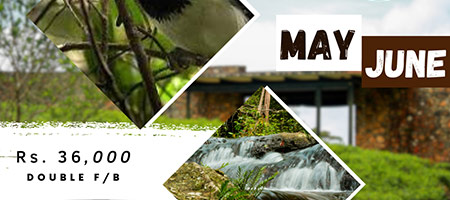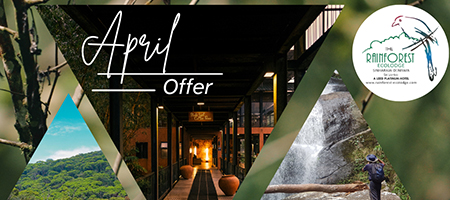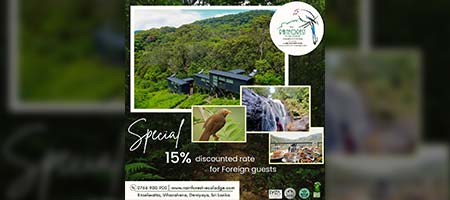Yellow-eared Bulbul (Pycnonotus penicillatus)
This is a fairly shy bird, it may sometimes appear on a perch close by, only to vanish as fast as it appeared. The sharp ‘whee, whee, whee’ call is unmistakable. When trees are fruiting, they gather in large numbers. It prefers mid-canopy and low bushes, but moves high up where the trees are fruiting.
They breed almost throughout the year with two peaks in March to May and August to October. They nest in an open cup shaped nest built at about 10 -15 ft. from the ground among dense foliage on upright forks. The nest is relatively thick and contains mostly green moss. The cup is lined with fine fern rootlets. Usually it lay two eggs.
Yellow- fronted Barbet (Magalaima flavifrons)
This bird generally occupies the top canopy. Its most characteristics trait is its call, which peaks during the breeding season. The birds starts calling during the breeding season. The birds start calling during the early part of the morning and continue for a few hours. They are often silent during most of the day. The crescendo begins again in the evening. During these hours their call becomes the most dominant sound in the forest and carries a long distance. During feeding the birds are silent; often a number of birds are feeding on the same fruit tree. They pick the fruit and swallow them whole. They have been observed to be regular members of the feeding flock in Sinharaja.
There are two marked breeding seasons, March to May and August to September, the first being the main period. The nest is excavated in a medium sized dead or decayed soft-wooded tree. It is usually dug in a vertical or near vertical stump. The nest chamber is usually 10 -20 ft above ground but there are nests located higher as well. Both birds excavate the nest chamber and there is no nesting material used. Incubation of eggs and feeding the young are done by both birds. The young are fed mostly on fruits and insects, but they also eat small animal such as gekos.
Layard’s Parakeet (Psittacula calthrapae)
This is a green parrot, with a bluish-grey head and back, separated by a green collar. There is a broad black chin stripe and the tail is blue tipped yellow. The female is similar, but has an all black beak and less green on the face than the male. Immature birds are mainly green, with an orange bill.
Layard’s parakeet prefers to be in the forest, particularly at the edges and in clearings, and frequent gardens too sometimes. It undergoes local movements, driven mainly by the availability of the fruit, seeds, buds and blossoms that make up its diet. Usually in small groups outside the breeding season and its call is a raucous chattering. It nests in holes in large trees, laying 3-4 white eggs.
Sri Lanka Junglefowl (Gallus Lafayettii)
The national bird of Sri Lanka. It is common in forest and scrub habitats and strongly sexually dimorphic. The male is much larger than the female, with more vivid plumage and a highly exaggerated wattle and comb. The comb is red with a yellow Centre. The female is smaller with dull brown plumage with white patterning on the lower belly and breast, ideal camouflage for a nesting bird.
It spends most of its time by scratching the ground for seeds, fallen fruits or insects. Lays 2-4 eggs in a nest either on the forest floor or in an abandoned nest of other birds or squirrels.
Sri Lanka Blue Magpie (Urocissa ornate)
These are shy but noisy birds, which usually move around in pairs or small groups. Members of the flock keep in contact by calls and lost birds are easily identified by the loud penetrating calls they make. Blue Magpie are omnivorous, feeding on insects, beetles and lizards and rather less on fruits. However, ripe fruit of keiya (Freycinetia pycnophylia) are a favourite.
They spend most of their time among foliage probing for morsels under tree bark and descend to the ground only in search of prey. They are active during the rainy season, especially when the rains are intermittent or soon after a shower of rain. They are incidental followers of mixed species feeding flocks in Sinharaja.
Blue Magpies breed from January to end of April. The Cluth varies from 3 to 5, with 4 being the most common. The preferred habitat of nest building is in close proximity to streams and rivers of undisturbed area. Nest construction is accomplished by the pair, assisted by other members of the flock. Both parents incubate and tend the young sharing the chores equally.
Sri Lanka Orange –billed Babbler (Turdoides rufescens)
This bird is known as the Ceylon Rufous Babbler as well, and is an inhabitant of the wet zone forests and wet hills up to the highest elevations. Often seen in adjoining home gardens and groves as well. Though similar in size and form to the Common Babbler, this species is much more attractive with its red-brown plumage and orange beak and legs.
Moves in flocks and usually a part of nucleus species of mixed feeding flocks. Food consists of both animal and vegetable matter. Has an energetic hop, but the flight is weak, confined to short spells from one patch to another. During the hot afternoons stay comparatively inactive, preening themselves or each other.
Ashy-headed laughingthrush (Garrulax cinereifrons)
This noisy bird is rufous brown above and deep buff below, with a grey head and white throat. Their characteristics laughing calls are often the best indication that they are present, since they are often difficult to see in their preferred habitat. Has short rounded wings and a weak flight. Due to extensive deforestation, their habitats have been threatened and noted that the population is dwindling.
Prefers to live in both edge and interior of primary and logged humid forests. Known as a ‘gap-edge’ specialist, being almost invariably associated with canopy gaps, even in deep areas away from forest boundaries.
Spotted winged thrush (Turdus spiloptera)
This bird is distributed in suitable forest cover, reasonably dense and undisturbed, from 1,000 — 4,000 ft. It is a shy bird keeping to the damp of dense forest floors and comes into open only in the late evening and early morning. The males call very frequently during the morning and late evening, sitting on low branches. When feeding an almost inaudible ‘tzee’ sound is made.
The nest, generally placed in a fork at about 5 to12 ft. above ground, is constructed with sticks and moss. The cup is deep and is neatly lined with fern-rootlets, grasses, decaying leaf matter etc. Two eggs are generally laid, but usually one will hatch.
Sri Lanka White-eye (Zosterops ceylonensis)
This bird’s distribution around the country is mainly above 3,000 ft., but has been recorded in Sinharaja at lower elevations of 900 ft. It is seen in both forested g and cleared areas such as plantations, provided adequate tall trees are present. Moves about in flocks, which can often number up to 1O -15 birds, calling to each other in a soft chirp. Prefers the top canopy and search flowers and tender shoots for insects.
The nest is a small cup suspended from a fork, generally 8 — 12 ft. above the ground, but in the plantation areas it may be higher, or even as low as 3 ft. in a tea bush. The nesting material is generally rootlets and mosses, and the outside of the nest is bound with cob-webs.
Mammals
Nearly half of the mammalian species in Sri Lanka are present in the Sinharaja forest region. Sinharaja is one of the few refuges of two arboreal non-primate mammals – the Golden palm Civet (paradoxurus zeylonensis) and Small flying squirrel (Petinomys fuscocapillus). The endemic and threatened primate – The purple-faced leaf Monkey is also found in the Sinharaja forest. A small herd of elephants roaming around the Delwala, Walanakanda and Rakwana range occasionally frequent the north-eastern part of Sinharaja. These elephants form one of the two populations remaining in the wet zone. Direct and indirect observations on the herd roaming the above areas indicate a population of 3-4 animals, including a well-grown bull. Compared to the dry zone elephants, they are dark in colour and much stouter in appearance. A lucky visitor may get the chance of observing an elusive wild cat in Sinharaja, either the Leopard, Fishing Cat or the smaller Rusty-Spotted Cat.
Purple-faced Leaf Monkey (trachypithecus vetulus)
A long-tailed arboreal monkey with generally brownish-black on the body and limbs. Coat colour varies with the subspecies. Though the common name suggests ‘purple’, the face is greyish—black. The thumb of this species is markedly reduced.
It normally has a ’unimale’ social system, usually consisting of one resident adult male with one to seven adult females and a number of sub adults, juveniles and infants. All-male groups also exist, numbering from 2 to 14 individuals. The group operates in its home range. Sometimes, the home ranges of all-male groups overlap but never those of unimale groups. The resident male will defend his territory aggressively against other males attempting to take over the harem.
This is a mainly leaf-eating species, but they do eat fruits, flowers and seeds when appropriate, a single offspring is born after a gestation period of 195 to 210 days.
Toque Macaque (Macaca sinica)
This species has a long tail and a golden brown coat on the top. They spend much of their time on the ground, but quite at home on the trees as well. They also can swim very well. They are omnivorous, mainly eat leaves, fruits seeds etc., and occasionally small birds too. Toque macaque lives in troops sometimes as large as 40, with a highly structured social strata. There are hierarchies among both males and females. When troops become very large, social tension and aggression among each other results in some individuals to flee the troop. The female macaque gives birth to a single offspring after a 5-6 month gestation period and the gap between offspring is usually 18 months. When young, offspring holds onto their mothers and learn social skills and survival techniques.
Common Birdwing / Ceylon Birdwing (Troides darsius)
This is the largest butterfly species in Sri Lanka and is endemic. It can be easily identified by its size and the yellow and black colours seen when flying. Adults are fairly common, flying high close to the tree tops at the edges of streams, rivers bordering forested areas and even in gardens or at the edges of the forest patches adjoining rural homes. They are strong fliers and active early in the morning up to midday and sometimes up to early afternoon. They exhibit a certain extent of territorial behaviour, in that they can be seen flying back and forth within the same stretch of stream edge/ garden or forested area. Their larval host plants are from the Family Aristolochia. In Sri Lanka most often recorded is Aristolochia indica, a small climbing plant that either occurs in the wild or is grown in rural gardens as it has medicinal properties.
Tree Nymph (Idea Iasonia)
This is an endemic species. A very large butterfly with a beautiful pattern of black markings on white background of its wings. The white background is sort of semi- transparent. The forewings are longer than the hind wings. The adults can be recognized easily by their size, colour pattern and by their slow and at times almost gliding flight with spread out wings along the high tree tops. It is a one of the slowest flying butterflies in the country. Seen at a distance they can appear to be almost hovering in one place with spread out wings. They are most commonly observed along the edges of streams, pathways and openings in the forest.







